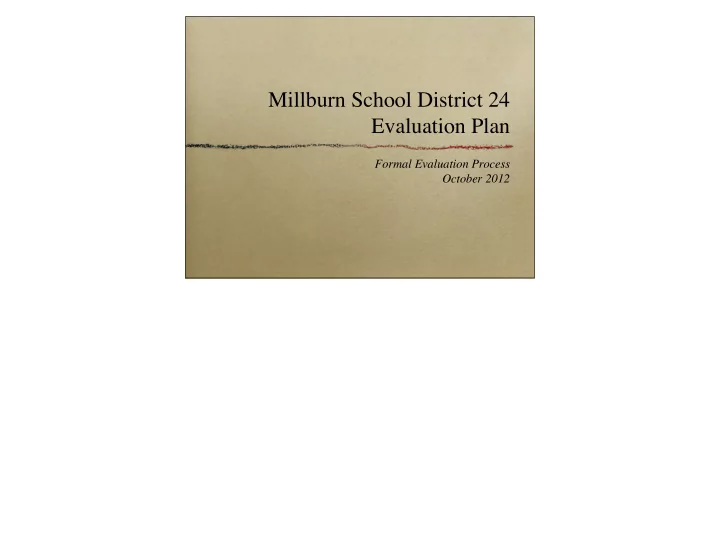

Millburn School District 24 Evaluation Plan Formal Evaluation Process October 2012
Agenda • Background Information • Components of District 24 Evaluation System • Observations - Formal, Informal • Forms Needed • What’s Next? • Questions?
An Effective Evaluation System • Promote student learning through the highest quality of teaching, which includes a commitment to continuous professional development and growth • Develop each individual’s capacity for professional contribution to the team, building and district levels • Support Millburn’s culture, vision, and mission
An Effective Evaluation System • Support new teacher growth through a formative process within clearly defined expectations • Support tenured teacher growth through a formative process that promotes collective inquiry, examination of practice, and self- reflection • Build and foster collaborative relationships among teachers and administrators
Components of Our System • Rubric used to observe classroom teaching • Single observer/evaluator over two-year cycle • Formal/Informal observation tools with feedback • Extensive training of the observers/evaluators • Professional Development activities focused on our system
Evaluation Rubric Based on Danielson Framework Domains Planning & Preparation Classroom Environment Instruction Professional Responsibilities Proficiency Levels Excellent Proficient Needs Improvement Unsatisfactory
Types of Observations Informal Observation • 15-20 minutes, can be in a variety of settings • Not scheduled in advance • May be included in summative evaluation rating if feedback provided in writing Formal Observation • 45 minutes, a complete lesson, or entire class period • Scheduled in advance with the teacher • Must have pre-observation conversation and post- observation reflection
Informal Evaluation • Informal Observation Form used for the purpose of documenting observed practices (p. 23) • Minimum of 3 informal observations in a two-year cycle for tenured staff (with at least 1 per year) • Data obtained from the informal observation will be used to guide teachers towards effective use of the Framework for Teaching • Data from the informal observations may be used for the formative process and summative evaluation
Informal Evaluation • The teacher may receive written communication about what was observed, such as an email or note from the evaluator. Informal observations shall only be included in the Final Summative Rating IF they are documented in writing • Observed practices that are harmful will be immediately addressed and corrected • For each informal observation the evaluator must provide the teacher with an opportunity for a face-to- face meeting to discuss the observation
Formal Observation Steps Pre-Observation • Review the Pre-Observation Conversation Form and be prepared to answer/discuss the questions and briefly respond to each section (this will not be turned in to the evaluator) (p. 25 and 26) • Remember to bring a copy of the form with you to the Pre-Observation Conversation along with any materials being used during the lesson • Review items on the Evidence/Data Guide that need to be available prior to the observation
Formal Observation Steps Observation • Evaluator will document the observation of teaching using the Classroom Observation Documentation form (p. 27) • Observable components are Domains 2 and 3 • Conversational components are Domains 1 and 4
Formal Observation Steps Post-Observation • A formative conversation will be held within 10 days after each formal observation • Review the Post-Observation Reflective Conversation Form and be prepared to answer/discuss the questions and briefly respond to each section (this will not be turned in to the evaluator) (p. 28) • The Formative Conversation/Summative Conference Form (Domains 2 and 3) will be used during the formative conversation (p. 29) • Formal Observation Post-Conference Summary Form (p.30)
Evidence/Data Guide Physical Layout of Room/Area Seating Arrangements Classroom Rules/Routines Rubrics Bulletin Boards (interactive, instructional, and affective) Student Projects And/Or Others, if appropriate
Evidence/Data Guide Units Extension/Enrichment ¡Activities Review/Reinforcement ¡Activities Modi7ication ¡for ¡Special ¡Needs Differentiation ¡Plan Flexible ¡Grouping ¡Plans Student ¡Work ¡Samples Homework ¡Assignments ¡and ¡Guides
Things to Help You Along the Way Teachscape Videos Charlotte Danielson’s “Enhancing Professional Practice: A Framework for Teaching” Rubrics Evidence/Data Guide
Forms • Informal Observation Form • Pre-Observation Conversation Form • Classroom Observation Documentation Form • Formative Conversation/Summative Conference Forms • Final Summative Evaluation Form
What’s Next? • Formal Observations will be completed by end of February • Your evaluator will contact you to schedule an observation time
In Review We’ve have: • Given background • Outlined the components • Explained formal and informal • Highlighted forms needed Questions?
Recommend
More recommend